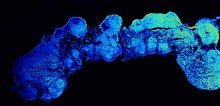
The study of the human brain now has one more powerful and innovative tool. It is a new 3D brain organoid model, which will give scientists a deeper insight into human-specific brain development and disorders, particularly those rooted in early developmental stages such as autism.
The new model is illustrated in the study ‘A polarised FGF8 source specifies frontotemporal signatures in spatially oriented cell populations of cortical assembloids’ just published in Nature Methods, and is the result of the collaborative work of an international team of researchers, led by Dr.Veronica Krenn, holder of the Human Technopole Early Career Grant at Milano-Bicocca, in collaboration with the team led by Professor Jürgen Knoblich of the Institute of Molecular Biotechnology of the Austrian Academy of Sciences (IMBA) in Vienna and the team led by Professor Giuseppe Testa of Human Technopole in Milan.